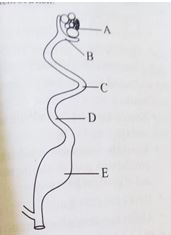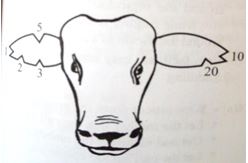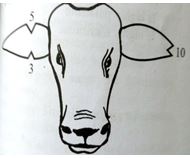- Define the following terms as used in livestock breeding (2mks)
- Hybrid Vigour (Heterosis)
- Epistasis
- Outbreeding
- Close breeding
- Outline four factors to consider when selecting a breeding stock (4mks)
- State any two disadvantages of inbreeding (1mk)
- List any four signs of heat in cattle (2mks)
- Just before birth, a farmer noticed that the hind legs and the tail of a calf were showing at the vulva.
- What name is given to this type of presentation? (1mk)
- Suggest a precaution the farmer should take under such conditions (1mk)
- State the common signs of parturition in Sows (2mks)
- Differentiate between the following Livestock management practices (2mks)
- Crutching and Ringing
- Flushing and steaming-up
- State four methods of identification in livestock production.( 2mks)
-
- Name two types of castration (1mk)
- Name any two kinds of livestock where a rubber ring can be used for castration (1mk)
- Highlight any five general methods of disease control (5mks)
- The diagram below shows the reproductive system of a hen.
- Name the parts labeled B, C , D and E (2mks)
- In which part does fertilization of the ova take place (1mk)
- State the roles of C and E in egg formation (2mk)
- State the gestation period for each of the following animals (2mks)
- Cow
- Sow
- Ewe
- Rabbit
- State the advantages of using organic mulch in farming (4mks)
- Give four reasons that would cause swarming of bees (4mks)
- Calculate the amount of K2O that would be contained in 600kg of a compound fertilizer, 30:20:10(N: P2O5: K2O respectively) (3mks)
- Name two common methods of preserving fish (1mk)
- Below is a method of identifying a cow
- Name the method of identification illustrated above (1mk)
- Name the tool used to carry out the practice ( 1mk)
- From the diagram state the number of the animal (1mk)
- Using the diagram, illustrate how you would identify an animal number 18
- State any four reasons for carrying out identification of animals. (2mks)
- Name four predisposing factors of animal diseases within an animal’s body.( 2mks)
- Why is the use of manure discouraged in carrot production? (1mk)
- Name two types of bees kept by the farmers (1mk)

Marking Scheme
- Define the following terms as used in livestock breeding (2mks)
- Hybrid Vigour (Heterosis)
- This refers to increased vigour and performance resulting from crossing two unrelated superior breeds.
- Epistasis
- This is the combination of genes which could have otherwise been inferior or undesirable
- Outbreeding
- Mating of animals which are not related
- Close breeding
- Breeding of very closely related animals
- Hybrid Vigour (Heterosis)
- Outline four factors to consider when selecting a breeding stock (4mks)
- Age- young animals that have not given birth more than three times
- Level of performance- select highly productive animals
- Physical fitness- select animals free from physical defect
- Health- select only healthy animals
- Behavior- cull animals with bad behaviors
- Good mothering ability
- Well adapted to environment
- Highly prolific
- Select animals producing high quality products
- State any two disadvantages of inbreeding (1mk)
- Loss of hybrid vigour
- Decline in fertility
- Reduction in performance
- High pre-natal mortality
- List any four signs of heat in cattle (2mks)
- Mounting on others and standing still when mounted
- Slight rise in body temperature
- Drop in milk yield
- Swelling and reddening of the vulva
- Slimy discharge from the vulva
- Mooing frequently
- Just before birth, a farmer noticed that the hind legs and the tail of a calf were showing at the vulva.
- What name is given to this type of presentation? (1mk)
- Breech Presentation/ malpresentation
- Suggest a precaution the farmer should take under such conditions (1mk)
- Assist the cow by repositioning to normal presentation
- Consult or seek the services of a qualified veterinary office
- What name is given to this type of presentation? (1mk)
- State the common signs of parturition in Sows (2mks)
- Restlessness
- Vulva turns red and swells
- The udder becomes full with milky fluid
- Sow builds a nest
- Differentiate between the following Livestock management practices (2mks)
- rutching and Ringing
- Crutching is the cutting of wool around the reproductive system of the ewe while ringing is the shearing of wool around the sheath of the ram around the service
- Flushing steaming-up
- Flushing – giving animal high nutritive feed before service while steaming up is the practice of giving an animal extra feed of high nutritive value during the last weeks of gestation.
- rutching and Ringing
- State four methods of identification in livestock production.( 2mks)
- Branding
- Tattooing
- Neck strap / chain
- Ear tagging
- Ear notching
-
- Name two types of castration (1mk)
- Open
- Closed
- Name any two kinds of livestock where a rubber ring can be used for castration(1mk)
- Bull, ram, Buck
- Name two types of castration (1mk)
- Highlight any five general methods of disease control (5mks)
- Proper selection and breeding
- Proper housing
- Parasite control
- Proper disposal of carcass
- Imposition of quarantine
- Observing high degree of hygiene
- Isolation
- Proper feeding and nutrition
- Treatment, prophylaxis and vaccination
- The diagram below shows the reproductive system of a hen.
- Name the parts labeled B, C , D and E (2mks)
- B-Funnel/ infundibulum
- C- Magnum
- D- Isthmus
- E- Uterus/ shell gland
- In which part does fertilization of the ova take place (1mk)
- B
- State the roles of C and E in egg formation (2mk)
- C- Addition of thick albumen
- E- Addition of the shell and shell pigments and more albumen
- Name the parts labeled B, C , D and E (2mks)
- State the gestation period for each of the following (2mks)
- Cow
- 270-285 days
- Sow
- 113-117 days
- Ewe
- 150 days
- Rabbit
- 28-32 days
- Cow
- state the advantages of using organic mulch in farming( 4mks)
- Reduces loss of moisture
- Improves soil fertility after decomposition
- Reduces splash erosion
- Regulates soil temperature
- Improves soil humus
- Improves water infiltration
- Helps to control pests
- Improves soil structure
- Give four reasons that would cause swarming of bees (4mks)
- Overcrowding
- Sick / infertile queen
- Dampness
- Lack of adequate ventilation
- Shortage of food and water
- Outbreak of parasites and diseases
- Calculate the amount of K2O that would be contained in 600kg of a compound fertilizer, 30:20:10(N:P2O5:K2O respectively)( 3mks)
10kg K2O is contained in 100kg of the fertilizer;
600kg fertilizer= 10 × 600
100
=60 Kg K2O - Name two common methods of preserving fish (1mk)
- Sun drying
- Smoking
- Salting
- Freezing/ refrigeration
- Below is a method of identifying a cow
- Name the method of identification illustrated above (1mk)
- Ear notching
- name the tool used to carry out the practice ( 1mk)
- Ear notcher
- From the diagram state the number of the animal (1mk)
- 41
- Using the diagram, illustrate how you would identify an animal number 18
- State any four reasons for carrying out identification of animals. (2mks)
- Allows selection of breeding purposes
- Enables culling of low producing animals
- Facilitates appropriate treatment of animals
- Stolen animals are easily recovered
- Enhances good record keeping
- Enhance proper feeding
- Name the method of identification illustrated above (1mk)
- Name four predisposing factors of animal diseases within an animal’s body.( 2mks)
- Age of the animal
- Color of the animal
- Sex of the animal
- Breed of the animal
- Presence of wounds
- Body conformation
- Physiological conditions
- Why is the use of manure discouraged in carrot production? (1mk)
- It induces forking of carrots hence reducing the quality of the produce
- Name two types of bees kept by the farmers (1mk)
- African bee
- European bee
Join our whatsapp group for latest updates
Tap Here to Download for 50/-
Get on WhatsApp for 50/-
Download Agriculture Questions and Answers - Form 3 Term 1 Opener Exams 2021.
Tap Here to Download for 50/-
Get on WhatsApp for 50/-
Why download?
- ✔ To read offline at any time.
- ✔ To Print at your convenience
- ✔ Share Easily with Friends / Students




